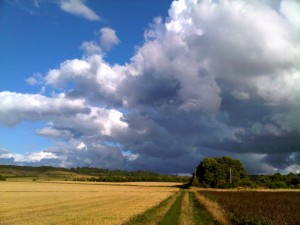Wherever you stand on Brexit, it’s hard not to take some comfort from the government’s proposed Environmental Land Management (ELM) scheme. This is the post EU strategy to introducing new ways of funding farmers with public money – moving from the basic payment principle to the “public money for public goods” approach.
I heard a little outlier, a simple trial scheme, described on the BBC’s Farming Today last week. A farmer in Somerset had created a short bund, and planted a new hedge on top of it, to stop floodwater running over part of a field. The scheme was easy to arrange, and he has been quickly paid for it out of public funds. Good for flood alleviation in the short-term, and nature in the medium to long-term. More Somerset farmers are being asked to bid for funds for schemes from a £40,000 pot to fund natural methods to tackle flooding on their land.
The taxpayer, through the EU, currently pays £2.5bn to English farmers under the the Basic Payment Scheme, under the Common Agricultural Policy (CAP). I wish ways could have been found to make CAP a more creative force for the environment. But that debate is over, and we should look forward to the ELM scheme, due to come into effect 2024, with keen interest.
Defra has commissioned a series of tests and trials, such as that modest Somerset scheme, to gather experience to inform what this new system, where the UK moves away from farm support based on direct payments to “public money for public goods” principle, could look like.
This month (March 2020) Defra published an elegant, well-written discussion document setting out the government’s “initial thinking”. Farmers have 10 weeks to respond.
The government’s current preference is a three-tier ELM. It believes previous schemes have been most successful when they have different “tiers”, “providing the option of tailoring different elements to different needs.”
Tier 1 would encourage environmentally sustainable farming.
Farmers would be paid for measures that help address their direct environmental impacts. It would include managing the amount of nutrients they apply, pest control, soil improvement, and planting cover crops or wildflower margins to encourage sustainable farming.
Tier 2, “locally targeted environmental outcomes”, could include items such as tree and hedge planting, habitat restoration, natural flood management, rights of way provision, recreation infrastructure and education services.
Tier 3 includes landscape scale land-use change projects, designed to help the government meet its more ambitious environmental targets, such as nature recovery and net zero carbon emissions. It might include woodland creation, peatland restoration and the creation of coastal habitats.
The government makes the usual supportive case for agriculture, “as an industry which is profitable, competitive and productive, while feeding the nation and taking care of our landscapes too”; while stressing that “no group has more power to reverse environmental decline than our farmers.”
But how will they be paid? Defra acknowledges that getting the sums right will be critical to ensuring that enough farmers involve themselves in ELMs.
Options include having government set the payments, and a market-based price setting, where payments are determined by mechanisms such as competitive tendering or auctions.
And, rather ominously, the amount to be made available to ELMs will not be known until later this year, once the government has completed its comprehensive spending review.
And the size of that, in the light of current events, is anyone’s guess.

